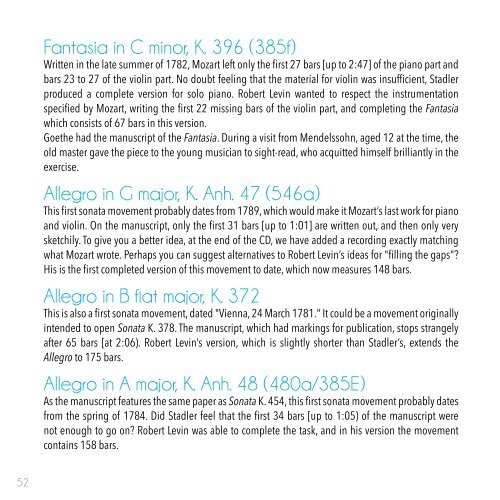Livret-Mozart-Levin-Poulet-La-Goillotte-Le-Palais-des-D%C3%A9gusteurs
Livret-Mozart-Levin-Poulet-La-Goillotte-Le-Palais-des-D%C3%A9gusteurs
Livret-Mozart-Levin-Poulet-La-Goillotte-Le-Palais-des-D%C3%A9gusteurs
Create successful ePaper yourself
Turn your PDF publications into a flip-book with our unique Google optimized e-Paper software.
Fantasia in C minor, K. 396 (385f)<br />
Written in the late summer of 1782, <strong>Mozart</strong> left only the first 27 bars [up to 2:47] of the piano part and<br />
bars 23 to 27 of the violin part. No doubt feeling that the material for violin was insufficient, Stadler<br />
produced a complete version for solo piano. Robert <strong><strong>Le</strong>vin</strong> wanted to respect the instrumentation<br />
specified by <strong>Mozart</strong>, writing the first 22 missing bars of the violin part, and completing the Fantasia<br />
which consists of 67 bars in this version.<br />
Goethe had the manuscript of the Fantasia. During a visit from Mendelssohn, aged 12 at the time, the<br />
old master gave the piece to the young musician to sight-read, who acquitted himself brilliantly in the<br />
exercise.<br />
Allegro in G major, K. Anh. 47 (546a)<br />
This first sonata movement probably dates from 1789, which would make it <strong>Mozart</strong>’s last work for piano<br />
and violin. On the manuscript, only the first 31 bars [up to 1:01] are written out, and then only very<br />
sketchily. To give you a better idea, at the end of the CD, we have added a recording exactly matching<br />
what <strong>Mozart</strong> wrote. Perhaps you can suggest alternatives to Robert <strong><strong>Le</strong>vin</strong>’s ideas for "filling the gaps"?<br />
His is the first completed version of this movement to date, which now measures 148 bars.<br />
Allegro in B flat major, K. 372<br />
This is also a first sonata movement, dated "Vienna, 24 March 1781." It could be a movement originally<br />
intended to open Sonata K. 378. The manuscript, which had markings for publication, stops strangely<br />
after 65 bars [at 2:06). Robert <strong><strong>Le</strong>vin</strong>’s version, which is slightly shorter than Stadler’s, extends the<br />
Allegro to 175 bars.<br />
Allegro in A major, K. Anh. 48 (480a/385E)<br />
As the manuscript features the same paper as Sonata K. 454, this first sonata movement probably dates<br />
from the spring of 1784. Did Stadler feel that the first 34 bars [up to 1:05) of the manuscript were<br />
not enough to go on? Robert <strong><strong>Le</strong>vin</strong> was able to complete the task, and in his version the movement<br />
contains 158 bars.<br />
52


